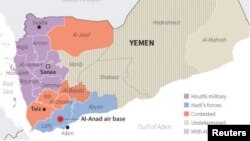A bomb-laden drone launched by Yemen’s Shiite rebels exploded over a military parade for the Saudi-led coalition and its allies on Thursday near the southern port city of Aden, killing at least six people in a brazen attack that threatened U.N.-brokered peace efforts to end the yearslong war tearing at the Arab world’s poorest nation.
The attack at the Al-Anad Air Base, where American special forces once led their fight against Yemen’s al-Qaida branch, targeted high-ranking military officials in Yemen’s internationally recognized government with what the rebel Houthis described as a new version of one of their drones.
The attack also raised new questions about Iran’s alleged role in arming the Houthis with drone and ballistic missile technology, something long denied by Tehran despite researchers and U.N. experts linking the Yemeni rebel weapons to the Islamic Republic.
“Once again this proves that the Houthi criminal militias are not ready for peace and that they are exploiting truces in order for deployment and reinforcements,” said Information Minister Moammar al-Eryani, who said two senior military officials were wounded in the attack.
“This is time for the international community to stand by the legitimate government and force the militias to give up their weapons and pull out of the cities,” he added.
The Houthis immediately claimed the attack through their al-Masirah satellite news channel, saying the attack targeted “invaders and mercenaries” at the base in the southern province of Lahj, leaving “dozens of dead and wounded.”
Yemeni officials said that among the wounded were Mohammad Saleh Tamah, head of Yemen’s Intelligence Service, senior military commander Mohammad Jawas, and Lahj governor Ahmed al-Turki, adding that authorities were still searching for wounded among the rubble. The officials spoke on condition of anonymity as they were not authorized to talk to reporters.
Local reporter Nabil al-Qaiti was attending the ceremony and standing in front of the stage when he saw a drone approach at a height of about 25 meters (82 feet) in the air, minutes after the parade started. Army spokesman Mohammed al-Naqib was delivering a speech from a podium when the drone exploded.
“It was a very strong explosion and we could feel the pressure,” he said, adding that two of the people standing next to him — a soldier and another journalist— were wounded. Al-Qaiti saw many wounded but no dead.
“The drone was packed with explosives,” he added.
Some 8,000 soldiers had been taking part in the parade, as well as two governors and a large number of top military commanders, including the chief of staff. Initial reports said six troops were killed.
Yemen plunged into civil war in 2014 when the rebels captured Sanaa, the country’s capital. A Saudi-led coalition entered the war in March 2015 as government forces looked poised to lose Aden to the Houthi advance. The U.S. supported the Saudi-led coalition for years despite its airstrikes killing civilians, only recently beginning to step back after the assassination of Washington Post columnist Jamal Khashoggi at the Saudi Consulate in Istanbul.
The two sides last month agreed to a prisoner swap and cease-fire in the port city of Hodeida, through which much of the country’s humanitarian aid flows, in an effort to provide relief to a country pushed to the brink of famine by the war.
Fighting has largely abated in Hodeida but progress on the withdrawal has been slow. The U.N. humanitarian aid chief Wednesday accused the rebels of blocking humanitarian supplies traveling from areas under their control to government-held areas.
The use of drones also raised new concerns over Iran’s influence in the conflict. Officials in the Saudi-led coalition have shown journalists a series of drones they said showed a growing sophistication by the Houthis, starting first with plastic foam models that could be built by hobby kit to one captured in April that closely resembled an Iranian-made drone.
Those drones have in the past been flown into the radar arrays of Saudi Arabia’s Patriot missile batteries, according to the research group Conflict Armament Research, disabling them and allowing the Houthis to fire ballistic missiles into the kingdom unchallenged.
Iran has been accused by the U.S. and the U.N. of supplying ballistic missile technology and arms to the Houthis, something Tehran denies.
Houthi media quoted its military describing the drone as a new variant of its Qasef, or “Striker,” drone. The drone, a Qasef-2K, has been designed to explode from a height of 20 meters — about 65 feet — in the air and rain shrapnel down on its target, according to the Houthis.
A United Nations panel of experts on Yemen issued a report in 2018 noting that the Houthi’s Qasef-1 drone “is virtually identical in design, dimensions and capability to that of the Ababil-T, manufactured by the Iran Aircraft Manufacturing Industries.” The Ababil-T can deliver up to a 45-kilogram (100-pound) warhead up to 150 kilometers (95 miles) away.
Such drones remain difficult to shoot down with either light or heavy weapons fire. Iraqi forces learned while driving out the Islamic State group from northern Iraq, where the extremists would load drones with grenades or simple explosives to target their forces.
Qasef drones are launched with pre-programmed coordinates to follow, unlike other drones where a pilot flies it with a video link, said Jeremy Binnie, a weapons expert who works as the Middle East and Africa editor at Jane’s Defence Weekly.
“They’re like slow missiles. Once they are launched, there is no control,” Binnie said. “They do have excellent intelligence on the ground. They needed to specifically know when those guys are in the stands to be able to target.”







